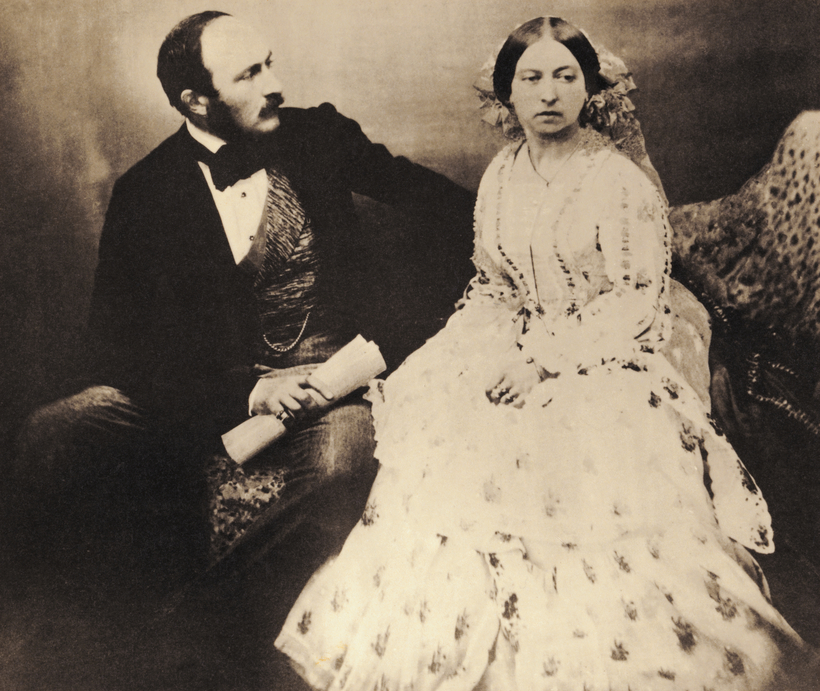Pity the poor biographer who is a contemporary of A. N. Wilson’s. At age 68, Wilson has written 28 works of nonfiction and 24 novels. He’s unafraid to take on major figures, among them Jesus Christ.
Pity the poor biographer even more when her husband comes into her office every year or so with a Cheshire Cat smile and says, “Guess who’s published another one!” My heart sinks, because I know he’s referring to Wilson, whom the tormenting husband calls “the Joyce Carol Oates of nonfiction.”
Not content with writing the life of Queen Victoria, Wilson has now produced a biography of her husband, Prince Albert, timed to his 200th birthday. And the poor biographer must admit: It’s superb.
He has dug deeply in the Royal Archives at Windsor Castle. He has trawled through libraries in Germany and—wouldn’t you know it—he also speaks German. But mostly he has applied his acuity not only to what made Prince Albert tick but to explaining what Wilson calls the “tense dynamic” of his 22-year marriage to the iconic Queen Victoria.
In Wilson’s telling, the frumpy old Queen of photographs turns out to be a regular hellcat. Her nine bouts of postpartum depression and her fierce rages would have sapped the strength of almost any man, but Albert navigated this marital turbulence with cool—some might say cold and controlling—equanimity. “My advice to be less occupied with yourself and your own feelings is actually the kindest I can give,” Albert wrote to her shortly before his death, in 1861, at age 42.
All the while he closely supervised the education of their children and plotted with the Queen to marry them off advantageously to European royals. Albert’s one glaring failure was the future King Edward VII, who Albert tried to mold in his own image of rectitude. When he fully grasped that his eldest son was hopelessly louche, it was “the destruction of all Albert’s unrealistic hopes.”
A Short, Fruitful Life
Prince Franz August Carl Albrecht Emanuel, son of Ernst, Duke of Saxe-Coburg-Saalfeld, and Luise, Princess of Saxe-Gotha-Altenburg, was known as Albert from his birth, in the summer of 1819. His deeply unhappy parents brought scandal on the family that forever mortified the sensitive prince—his father kept a mistress, and his mother had affairs. Shortly after Albert’s fifth birthday, Ernst banished Luise and later divorced her.
Albert was rigorously educated, first by a squadron of tutors instilling skills and disciplines in 11-hour days that produced what Wilson calls his “narcotic of constant work.” Albert then did a stint in Brussels learning statecraft at the knee of his father’s brother, King Leopold of Belgium, followed by “three years’ worth of work into three semesters” at the Bonn University. From 1836 until he drew his last breath, Albert was closely guided by Baron Christian Friedrich von Stockmar—“half Merlin, half Puck”—who exercised power with a “sharp-edged slyness.”
Stockmar met Albert through his friendship with King Leopold. The courtier’s “beady little eyes” instantly spotted promise in Albert’s “receptive mind.” Throughout his marriage, Albert applied Stockmar’s benevolent Enlightenment principles as he worked with Victoria to modernize the British constitutional monarchy by staying above partisanship, holding their family to high standards, and exhibiting a genuine social conscience.
It is impossible to encapsulate Albert’s stunning accomplishments in little over two decades. But consider Britain without Royal Albert Hall and the museums and educational institutions in “Albertopolis” near London’s Hyde Park. There’s Balmoral Castle in Scotland and Osborne House on the Isle of Wight, both created by Albert, and the murals lining the walls of the Houses of Parliament that he commissioned. Albert helped reform Cambridge and other British universities, promoted science and technology, championed housing for the poor, and established proper military training at Sandhurst and Wellington College. No other public figure in British history, writes Wilson, “even touches him.”
But it was as Victoria’s “Angel” that the prince consort (so named in 1857) had his greatest effect. As a 17-year-old princess, Victoria initially balked at an arranged marriage with her first cousin—the son of her mother’s brother—dismissing him as “very stout.” But once she committed to Albert at the altar in the Chapel of St James’s, in 1840, she engulfed him with her passion and poured her rhapsodic emotions onto the pages of her journals and letters, even calling herself his “slave-girl.”
No other public figure in British history, writes Wilson, “even touches Prince Albert.”
While Albert devoted himself to Victoria, his love was dutiful and lacked her ardor. Wilson concludes that Albert ensured Victoria “was laid low, on a regular basis, in childbed,” so he could act on her behalf. Until he encountered fiery Victoria, Albert had been indifferent to the romantic allure of women. Wilson portrays the royal couple as “two fallible beings, whose egos clashed, but who remained lovers to the end, and who were in every sense partners.”
In his most controversial judgment, Wilson writes that Victoria “rejoiced in the ‘feminine’ side of Albert’s character,” and the prince seemed “to be gay in all but sexual preference—the obsession with interior decoration, music, clothes, the desire for order and control.” Indeed, in Wilson’s view, their marriage resembled “an intense relationship between two women.”
Wilson establishes a confiding tone with the reader, consciously assuming the role of slightly subversive guide, admitting at one point that some might grow “weary of Albert’s relentless virtuousness,” at another that his studies would “seem esoteric and boring.” Wilson impishly uses colloquialisms such as “bling” and “humdinger of a row,” his style swinging from erudite to saucy.
Albert’s star turn was the Great Exhibition of 1851 in London—a testament to Britain’s imperial power and industrial dominance—and Wilson’s pace slackens as he plows through the development of this ambitious project. Yet many other details are irresistible—such as the moment when the 24-year-old prince ended his “desperate war” on encroaching baldness by shaving his head and wearing a wig. Wilson’s breadth of knowledge and shrewd insights create a compelling portrait of the awkward aesthete who set the British royal family “at the heart of nineteenth century change.”
Sally Bedell Smith is the author of Prince Charles: The Passions and Paradoxes of an Improbable Life and Elizabeth the Queen: The Life of a Modern Monarch.


